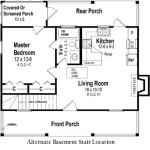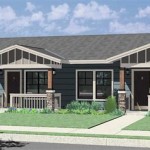Plan Of The House Design
The house plan is a critical aspect of the construction process. It outlines the layout, size, and features of the house, ensuring that the final product meets the homeowner's needs and desires. Creating a detailed and well-thought-out house plan is essential for several reasons:
1. Visualization: The house plan provides a visual representation of the house before construction begins. It allows homeowners to see how the different spaces in the house will flow together and get a sense of the overall design.
2. Communication: The house plan serves as a communication tool between the homeowner, architect, and contractor. It ensures that everyone involved in the construction process has a clear understanding of the intended design, reducing the chances of miscommunication or errors.
3. Cost Control: A well-designed house plan can help control construction costs by identifying potential inefficiencies or areas where materials can be saved. By planning ahead, homeowners can avoid costly changes or rework during construction.
4. Building Permit: Most municipalities require a building permit before construction can commence. The house plan is a key part of the permit application process, as it demonstrates that the house meets local building codes and zoning regulations.
5. Future Modifications: Having a detailed house plan can be invaluable if homeowners decide to make any modifications to their house in the future. It provides a reference point for additions, renovations, or alterations, ensuring that the changes are compatible with the original design.
Creating a House Plan: Developing a house plan typically involves the following steps:
1. Determine Needs: Start by defining the necessary spaces and features for the house, such as the number of bedrooms, bathrooms, a living room, a kitchen, and storage areas. Consider the lifestyle and daily routines of the occupants.
2. Site Analysis: Evaluate the building site, taking into account factors such as topography, soil conditions, sun exposure, and access to utilities. This information will influence the house's orientation, foundation design, and overall layout.
3. Design Concept: Sketch out a preliminary design that incorporates the desired spaces and features within the site constraints. Experiment with different layouts to optimize space utilization and create a functional flow.
4. Detailed Drawings: Develop detailed drawings that include floor plans, elevations, sections, and details. These drawings should accurately represent the dimensions, materials, and construction methods to be used.
5. Review and Approval: Once the drawings are complete, have them reviewed by an architect or engineer to ensure they meet building codes and structural requirements. Make any necessary adjustments before finalizing the house plan.
Conclusion: A well-planned house plan is a roadmap for a successful construction project. It provides a clear understanding of the house's design, facilitates communication, controls costs, and ensures compliance with regulations. Homeowners who take the time to develop a detailed and thoughtfully considered house plan will ultimately create a home that meets their unique needs and enhances their quality of life.

Small House Design 2024001 Pinoy Eplans Floor Plans

Small House Design 2024005 Pinoy Eplans Modern Plans Layout

House Plans How To Design Your Home Plan

Small House Plans Popular Designs Layouts

Top 5 Modern House Plans With Photos Floor Archid

House Plans How To Design Your Home Plan

18 Small House Designs With Floor Plans And Decors

Small House Design Shd 2024007 Pinoy Eplans

Check Out These 3 Bedroom House Plans Ideal For Modern Families

Simple Yet Elegant 3 Bedroom House Design Shd 2024031 Duplex Plans Unique Three Plan








